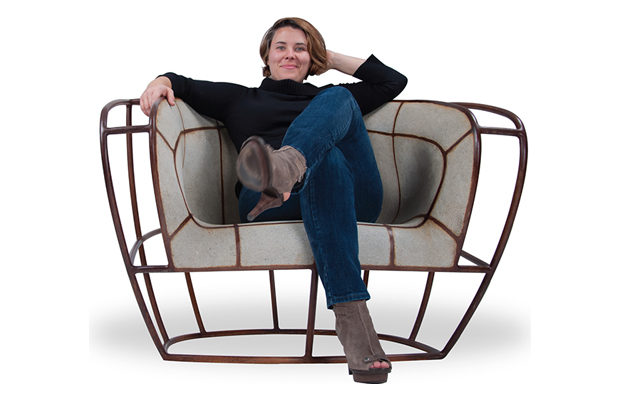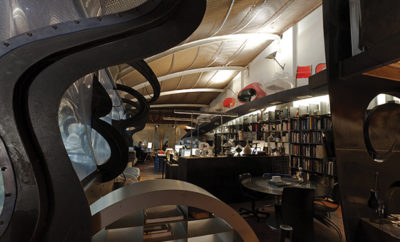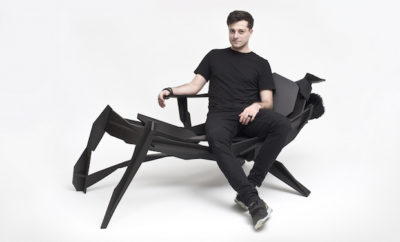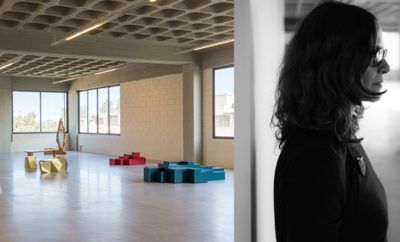 The artist seated in her steel and cement Low Rider Chair of 2013.
The artist seated in her steel and cement Low Rider Chair of 2013.
Design
From the Archives: Redrawing the Lines
A contemporary furniture maker’s take on American design
Furniture maker Vivian Beer has established a reputation for taking risks. She manipulates a welder the way traditional furniture makers use a hand plane, and her materials of choice are distinctly industrial: stainless steel, concrete, and automotive paint. Beer creates her arresting works in a subterranean studio in Manchester, New Hampshire, and her “studio mates” are restorers of classic cars who trade stories over beers in the lounge. The irony of this milieu reflects the wit of Beer’s work—a heady mix of modern and historical, industrial and custom, rough and elegant, masculine and feminine. Beer plays with these stereotypes the same way that she plays with techniques, and the results are eye-popping.
Beer, who holds a B.F.A. in sculpture from the Maine College of Art and an M.F.A. in metalsmithing from the Cranbrook Academy of Art, has been working on her own since 2006. In that time, She has exhibited extensively and has worked in five different shops in North Carolina, New York, New Hampshire, and California, most recently completing a Windgate artist-in-residency at San Diego State University (her second—the first, in 2011, was at the State University of New York in Purchase). “Travel offers me the opportunity to change my perspective, which is vital in producing fresh work,” Beer observes. “You can’t just stay in your studio.”

Beer’s 96-inch-long Forth Bench, in stainless steel, pure pigment, and ferrocement (concrete), was designed in 2011.
Beer’s methodology is cerebral, combining a deep knowledge of industrial design with a love of the decorative arts. Her design process, however, is decidedly hands-on, artfully blending a practical knowledge of materials with a sculptor’s eye toward sign and signifier. Beer refers to this use of abstraction in her design process as “creative sampling.” A perfect example of this distillation of metaphors and forms can be found in Forth bench, a design that she originated in 2011 and has continued to refine. Her goal for this piece was to construct a contemporary version of the eighteenth-century “conversation chair” or “tête-à-tête.” Traditionally, conversation chairs include a division between the occupants, a barrier that Beer wished to eliminate. “I wanted to create a conversation chair that felt emotionally intimate,” she notes, “so I reflected on the times that I had felt that way, and I realized that it was when I was sitting in a hammock with another person—you’re in a concave nest, sharing the same space yet not impinging on one another.”
The user’s physical experience of her furniture, however, is only one component of this artist’s vision; Beer is also keen to imbue her works with a sense of history and emotion through the visual cues she includes. “When I conceived this piece, I didn’t set out to make a chair,” Beer observes, “I wanted to create an experience. I like to pull aesthetics together to create a conglomeration of metaphors.”
Delving into these cues (which Beer refers to as cultural access points) is like peeling back the layers of an onion. Forth Bench’s smooth, hard, swooping expanses of stainless steel immediately evoke thoughts of cantilevers and metal trusses. This is no accident; Edinburgh’s famous Forth Bridge—the world’s second longest single span bridge—was the inspiration. Beer juxtaposes this rugged aesthetic with a playful visual contrapunto—resting her “human bridge” on delicate, 1 ½-inch-square toes, creating the impression that the bench may dance away at any moment. Beer also alludes to the shared emotional purpose of bridge and bench, both of which are designed to facilitate interaction and exchange.

Beer’s Ruby Red Slipper Chair of 2010 in steel with automotive paint is also known as Anchored Candy no. 3.
“Vivian is arguably one of the most talented young designer-makers that I‘ve seen in a long time,” notes Lewis Wexler, owner of Philadelphia’s Wexler Gallery. “Her creative use of industrial materials in producing well designed, yet functional furniture sets her apart from many others in the field. Her work is multilayered, steeped in design references from pop culture, fashion, car culture, and industrial design. From the very first piece of Vivian’s I saw years ago, I was hooked. I just knew she had the potential to create great objects and she has never disappointed. Vivian has a great career ahead of her and I am honored to be representing her.”
Edward S. Cooke Jr., the Charles F. Montgomery Professor of American Decorative Arts at Yale University and an expert in the field of studio furniture, is also a fan. “Vivian Beer takes the most common of metals and then shapes and finishes them with a high degree of refinement,” he observes. “Her sense of the lyric possibilities of the materials, attention to the workmanship that realizes those forms and exploration of the color and depth of the finish combine to animate each of her works with a personality. She is neither a blacksmith nor a furniture maker, but rather a sort of hybrid shaper of form with a solid base in material and technique.”
Speaking for herself, Beer says she is simply committed to turning out the best work she can. “I’m trying to make good, smart, self-aware work—things that should be in the world,” she asserts. Clearly, she is well on her way.
Photos by Alison Swiatocha












